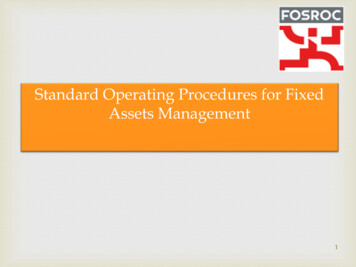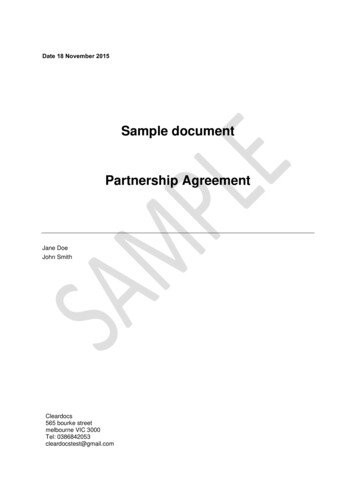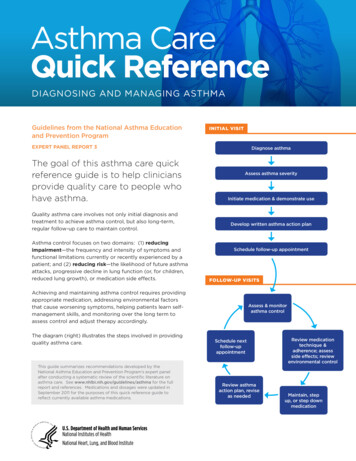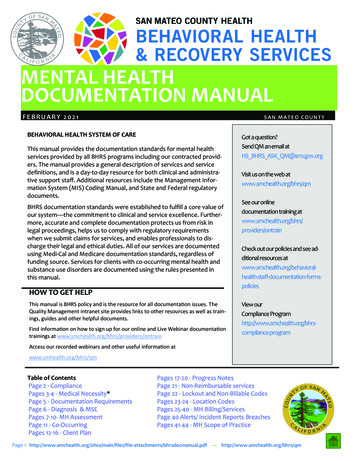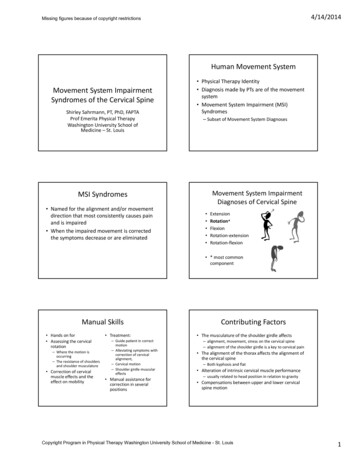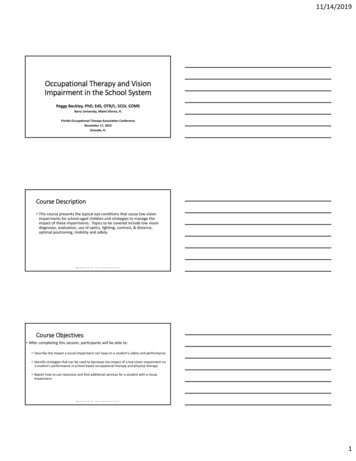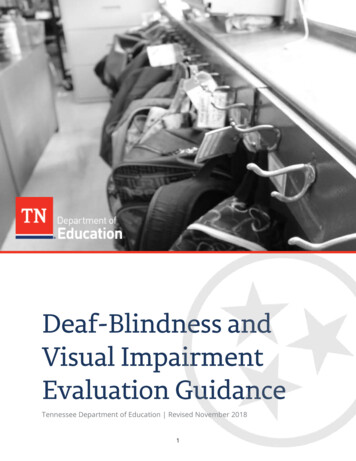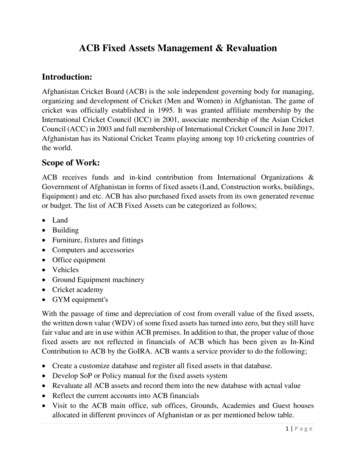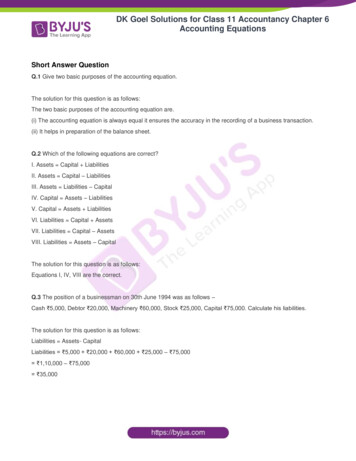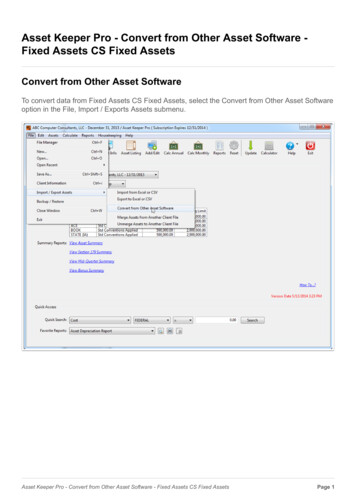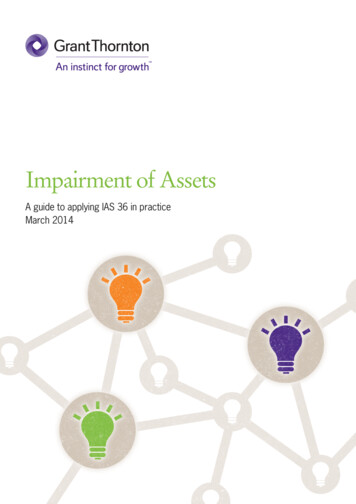
Transcription
Impairment of AssetsA guide to applying IAS 36 in practiceMarch 2014
“Grant Thornton” refers to the brand under which the Grant Thornton member firmsprovide assurance, tax and advisory services to their clients and/or refers to one ormore member firms, as the context requires. “GTIL” refers to Grant Thornton InternationalLtd (GTIL). GTIL and each member firm of GTIL is a separate legal entity. GTIL is anon-practicing, international umbrella entity organised as a private company limited byguarantee incorporated in England and Wales. GTIL does not deliver services in its ownname or at all. Services are delivered by the member firms. GTIL and its member firmsare not agents of, and do not obligate, one another and are not liable for one another’sacts or omissions. The name “Grant Thornton”, the Grant Thornton logo, including theMobius symbol/device, and “Instinct for Growth” are trademarks of GTIL. All copyright isowned by GTIL, including the copyright in the Grant Thornton logo; all rights are reserved.Important Disclaimer:This document has been developed as an information resource. It is intended as a guideonly and the application of its contents to specific situations will depend on the particularcircumstances involved. While every care has been taken in its presentation, personnelwho use this document to assist in evaluating compliance with International FinancialReporting Standards should have sufficient training and experience to do so. No personshould act specifically on the basis of the material contained herein without consideringand taking professional advice. Neither GTIL, nor any of its member firms, accept anyresponsibility for any errors it might contain, whether caused by negligenceor otherwise, or any loss, howsoever caused, incurred by any person as a result ofutilising or otherwise placing any reliance upon this document.Grant Thornton International Ltd is a company limited by guarantee incorporated inEngland and Wales.Registered number: 05523714Registered office: Grant Thornton House, 22 Melton Street, Euston Square, London,NW1 2EP UK
IntroductionImpairment of AssetsInternational Accounting Standard 36 ‘Impairmentof Assets’ (IAS 36, the Standard) is not new. Infact, the Standard was first issued in 1998 and laterrevised in 2004 and 2008 as part of the InternationalAccounting Standards Board’s (IASB’s) work onthe business combinations project. Since then onlyminor consequential amendments have been made.However, although IAS 36’s requirementsare familiar, the impairment review remainschallenging in practice. IAS 36’s guidance isdetailed, prescriptive and complex in some areas.Putting this guidance into practice involvesmaking long-term estimates of uncertain futureperformance and the valuation of assets andoperations for which observable prices are often notavailable. This also requires a significant degree ofprofessional judgement. Against this background,financial statement users, regulators and accountingenforcement bodies continue to raise concernsabout the rigour of entities’ impairment assessments,the supportability of their underlying assumptionsand the transparency of the related disclosures. Inview of these challenges, a reminder of IAS 36’srequirements and key application issues is timewell spent.Fortunately, Grant Thornton – one of theworld’s leading organisations of independentassurance, tax and advisory firms with morethan 35,000 Grant Thornton people across over100 countries – has gained extensive insightsinto the application of IAS 36. Grant ThorntonInternational Ltd (GTIL), through its IFRS team,develops general guidance that supports theGrant Thornton member firms’ commitment tohigh quality, consistent application of IFRS. Weare pleased to share these insights by publishing‘Impairment of Assets: A guide to applying IAS 36in practice’ (the Guide).Using the GuideThe Guide has been written to assist managementin understanding the requirements of IAS 36 whilehighlighting some common areas of confusion seenin practice. More specifically it: summarises the overall objective and basicrequirements of IAS 36 provides a step-by-step guide to performingan impairment assessment, and when required,testing for and/or recording or reversingimpairment in accordance with IAS 36 highlights interpretative and practicalapplication issues that arise when performingthese steps (see top 10 issues list on thefollowing page) offers insights on best practices to addressthese issues.To achieve these objectives, the Guide is organisedas follows:Impairment of Assets: a guide to applying IAS 36 in practice i
Overview of the GuideSection A:IAS 36 at a glanceThis Section provides an ‘at a glance’ overview of IAS 36’s main requirements and outlines the majorsteps in applying those requirements. These steps are organised broadly into the following: What? (Determining the scope and structure of the impairment review) If and when? (Determining if and when a quantitative impairment test is necessary) How? (Understanding the mechanics of the impairment test and how to recognise or reverse anyimpairment loss, if necessary).Section B:What?This Section looks at the scope of the impairment review (ie the types of assets that are included) andhow it is structured (ie the level at which assets are reviewed). Assets must be reviewed for impairmentat the lowest level possible – sometimes this is the individual asset but more often assets must beallocated to a cash generating unit (CGU) for impairment review purposes. Further, goodwill andcorporate assets will need to be allocated to a CGU or groups of CGUs. This Section covers the followingtwo Steps of the impairment review: Step 1: Identify assets within the scope of IAS 36 Step 2: Determine the structure of the impairment review.Section C:If and when?This Section explains if and when a detailed impairment test is required. The guidance prescribes differentrequirements for goodwill and indefinite life intangible assets (including those not ready for use) whencompared to all other assets. As such, this Section will cover the following Step in the impairment review: Step 3: Determine if and when to test for impairment.Section D:How?This Section explains the process for the quantitative impairment test – in other words estimating therecoverable amount of the asset or group of assets and comparing this to the carrying value. Theimpairment test determines if an entity needs to record an impairment loss or reverse a previous loss.This Section covers the following Steps: Step 4: Estimate the recoverable amount Step 5: Compare recoverable amount with carrying amount Step 6: Recognise or reverse any impairment loss.Section E:Other impairment issuesThis Section discusses other common application issues encountered when applying IAS 36, includingthose related to: the ‘deferred tax and goodwill problem’ non-controlling interests equity accounting the interaction between IAS 36 and other IFRSs.Section F:DisclosuresThis Section provides a summary of the IAS 36 disclosure requirements and highlights particular areasof focus for regulators, including select illustrative examples for these areas of focus.Top 10 pitfalls in applying IAS 36In our experience, certain aspects of IAS 36 prove consistently challenging and problems in these areasare frequently identified by regulators. For ease of reference, the table below summarises ten of themost common pitfalls with references to the relevant section of the Guide.IssueGuide referenceIdentifying CGUs at too high a levelDealing with corporate assets in the impairment reviewConsidering the market capitalisation indicatorFailing to assess impairment indicators, and test if necessary, at interim periodsEstimating value in use: ensuring assumptions are reasonable and supportableEstimating value in use: what to include and exclude in the cash flow estimatesEstimating value in use: using a pre-tax discount rate that reflects the specific risks of each asset or CGUFailing to make a ‘like-for-like’ comparison of carrying value and recoverable amountGrossing-up goodwill for non-controlling interestsMissing, inadequate or ‘boilerplate’ disclosuresSection B.2.1Section B.2.2.2 and D.2.2Example C.1Section C.1 and E.4.1Section D.1.3.1Section D.1.3.1Section D.1.3.2Section D.2.1Section E.2Section FGrant Thornton International LtdMarch 2014ii Impairment of Assets: a guide to applying IAS 36 in practice
ContentsIntroduction iA. IAS 36 at a glance 1 Summary of IAS 36’s main requirements 2 IAS 36’s impairment approach – step by step 124B. IAS 36’s impairment review – What? 1 Step 1: Identify assets within the scope of IAS 36 2 Step 2: Determine the structure of the impairment review 2.1 Step 2.1: Identify cash generating units (or groups of CGUs) 2.1.1 Roles of the cash generating unit in the impairment review 2.1.2 Identifying cash generating units 2.1.3 Changes in identified cash generating units 2.2 Step 2.2: Allocate assets to the cash generating units 2.2.1 Operational assets 2.2.2 Corporate assets 2.2.3 Goodwill A. Provisional allocation of goodwill B. Reallocation of goodwill 668C. IAS 36’s impairment review – If & when? 1 Step 3: Determine if and when to test for impairment 1.1 Indicator-based impairment testing 1.2 Annual impairment testing 1.2.1 Timing of the annual impairment test 101010131415151719202222222526
D. IAS 36’s impairment test – How? 1 Step 4: Estimate the recoverable amount 1.1 Recoverable amount 1.2 Fair value less costs of disposal 1.3 Value in use 1.3.1 Estimating the future cash inflows and outflows 1.3.2 Applying the appropriate discount rate 1.3.3 Foreign currency issues 1.4 Exceptions to calculating both fair value less costs of disposal and value in use 2 Step 5: Compare recoverable amount with carrying amount 2.12.2E.12342728293035383840Like-for-like comparison of recoverable amount and carrying amount of a cash generating unit 402.1.1 Exceptions to the rule – including other assets and liabilities 41The order of impairment testing for corporate assets and goodwill 432.2.1 Order of testing for corporate assets that cannot be allocated 432.2.2 Order of testing for assets and cash generating units to which goodwill has been allocated 443 Step 6: Recognise or reverse any impairment loss 3.1 Recognising an impairment loss for an individual asset 3.2 Recognising an impairment loss for cash generating units 3.3 Considerations for foreign operations 3.4 Reversing an impairment loss 3.4.1 Indicators for reversing an impairment loss 27273.4.2 Reversing impairment losses for individual assets (other than goodwill) 3.4.3 Reversing impairment losses for cash generating units 4546485051515253Other impairment issues Deferred tax and goodwill problem Non-controlling interests IAS 36 and equity accounting Interaction between IAS 36 and other IFRS Standards 4.1 IAS 36 and IAS 34 ‘Interim Financial Reporting’ 4.2 IAS 36 and IAS 10 ‘Events after the Reporting Period’ 5656586063Disclosures Summary of IAS 36 disclosure requirements Application issues (as noted by regulators) Select illustrative examples 6565697063634.3 IAS 36 and IFRS 5 ‘Non-current Assets Held for Sale and Discontinued Operations’ 644.4 IAS 36 and IAS 37 ‘Provisions, Contingent Liabilities and Contingent Assets’ 64F.123
A. IAS 36 at a glanceSection A:IAS 36 at a glanceThis Section provides an ‘at a glance’ overview of IAS 36’s main requirements and outlines the majorsteps in applying those requirements. These steps are organised broadly into the following: What? (Determining the scope and structure of the impairment review) If & when? (Determining if and when a quantitative impairment test is necessary) How? (Understanding the mechanics of the impairment test and how to recognise or reverse anyimpairment loss, if necessary).The objective of IAS 36 is to outline the procedures that an entity applies to ensure that its assets’ carryingvalues are not stated above their recoverable amounts (the amounts to be recovered through use or sale ofthe assets). To accomplish this objective, IAS 36 provides guidance on: the level at which to review for impairment (eg individual asset level, CGU level or groups of CGUs) if and when a quantitative impairment test is required, including the indicator-based approach for anindividual asset that is not goodwill, an indefinite life intangible asset or intangible asset not yet readyfor use how to perform the quantitative impairment test by estimating the asset’s (or CGU’s)recoverable amount how to recognise an impairment loss when and under what circumstances an entity must reverse an impairment loss and finally disclosure requirements (IAS 36.1).The Standard defines key terms that are essential to understanding its guidance. The most significantdefinitions are highlighted in Figure A.1 below and others will be introduced in the relevant sectionsof the Guide:Figure A.1 – Select key terms in IAS 36 (IAS 36.6)TermDefinitionCarrying amountThe amount at which an asset is recognised after deducting any accumulateddepreciation (amortisation) and accumulated impairment losses thereonImpairment lossThe amount by which the carrying amount of an asset or a CGU exceeds itsrecoverable amountRecoverable amountThe higher of an asset or CGU’s fair value less costs of disposal (FVLCOD) andits value in useValue in use (VIU)The present value of the future cash flows expected to be derived from anasset or CGUImpairment of Assets: a guide to applying IAS 36 in practice: Section A 1
1 Summary of IAS 36’s main requirementsFigure A.2 summarises IAS 36’s main requirements.Figure A.2 – Summary of IAS 36’s main requirementsIAS 36 (or related IFRS) referenceRequirementsObjective(IAS 36.1)IAS 36 prescribes the procedures to ensure that assets are carried at no more than their recoverableamount. To meet this objective, IAS 36 provides guidance on: the level at which to assess and test for impairment (individual asset level, CGU level, etc.) if and when a quantitative impairment test is required for particular assets how to perform the impairment test (ie to determine if the recoverable amount exceeds the carryingvalue for an asset or group of assets) how to record and reverse impairment losses the detailed disclosure requirements (both in the case of impairment and also in the absence of impairment)PrincipleThe guiding principle in IAS 36 is that assets should not be carried above their recoverable amountScope(IAS 36.2-5)IAS 36 applies to all assets other than those for which the measurement requirements of other IFRSs aresuch that an IAS 36-based impairment review is irrelevant or unnecessary. Assets outside IAS 36’s scopeinclude: inventories, financial assets, assets arising from construction contracts, deferred tax assets, assetsarising from employee benefits, assets classified as held for sale, assets arising from an insurer’scontractual rights under insurance contracts, investment property measured using the fair value modelor biological assetsIAS 36 does apply to: financial assets classified as subsidiaries, associates and joint ventures (unless measured at fair value) property, plant and equipment and intangible assets carried at a revalued amount in accordance withother IFRSsKey definitions(IAS 36.6)IAS 36 defines key terms that are essential to understanding its guidance including, but not limited to: CGU corporate assets costs of disposal impairment loss recoverable amount VIU FVLCODIdentifying an asset that may be impaired(IAS 36.7-14)IAS 36 prescribes the timing requirements for performing quantitative impairment testing as well aspotential ‘indicators’ of impairment that may trigger impairment testing for some assets or groups of assets.Specifically, IAS 36 requires that: goodwill, indefinite life intangibles and intangible assets not yet available for use are tested forimpairment at least annually, in addition to when there is any indication of impairment all other assets are tested for impairment when there is any indication that the asset may be impaired(IAS 36.15-16)IAS 36 also outlines limited exceptions to the requirements noted aboveLevel of review (individual asset or groupof assets)(IAS 36.22)(IAS 36.65-79)IAS 36 prescribes the level of review for impairment: where possible, an entity will estimate the recoverable amount of an individual asset when this is not possible, an entity will determine the recoverable amount of the CGU to which an assetbelongs(IAS 36.80-99)(IAS 36.100-103)For the purposes of impairment testing, IAS 36 prescribes how to allocate the following to CGUs: goodwill corporate assets2 Impairment of Assets: a guide to applying IAS 36 in practice: Section A
IAS 36 (or related IFRS) referenceRequirementsMeasuring recoverable amount(IAS 36.18-24)When an entity needs to test an asset or CGU for impairment, it must determine its recoverable amount. IAS36 defines the recoverable amount as the higher of the asset’s or CGU’s FVLCOD and VIUFVLCOD(IAS 36.28-29, 78)IAS 36 provides guidance to determine FVLCOD including: providing examples of ‘costs of disposal’ and items that do not meet that definition outlining situations where it may be necessary to consider some recognised liabilities to determine therecoverable amountVIU(IAS 36.30-57, Appendix A)IAS 36 prescribes the elements that should be reflected in the calculation of an asset’s or CGU’sVIU including: an estimate of the future cash flows the entity expects to derive from the asset expectations about possible variations in the amount or timing of those future cash flows the time value of money the price for bearing the uncertainty inherent in the asset other factors such as illiquidity that market participants would reflect in pricing the future cash flows theentity expects to derive from the assetThe guidance provides additional considerations in determining an appropriate estimate/rate for each of theabove elementsRecognising an impairment loss(IAS 36.58-64)(IAS 36.104-108, Appendix C)IAS 36 requires an entity to recognise an impairment loss when the carrying amount of an asset or CGUexceeds its recoverable amount, and provides guidance on how to recognise that loss, by: outlining the requirements for recognising and measuring impairment losses for an individual asset outlining the requirements for allocating losses when such losses are calculated for a CGU providing additional considerations for allocating an impairment loss when there is a non-controllinginterestReversing an impairment loss(IAS 36.109-125)IAS 36 sets out the requirements for reversing an impairment loss recognised for an asset or CGU in priorperiods by: prescribing timing for assessment providing indicators that an impairment loss recognised in prior periods for an asset (other than goodwill)or CGU may no longer exist or may have decreased prescribing the accounting for reversing a prior impairment loss, including limitations on the amount thatcan be reversedDisclosures(IAS 36.126-137)IAS 36 sets out the disclosure requirements related to impairment. Some disclosures apply in the event anentity records an impairment loss while others are required irrespective of any impairment lossImpairment of Assets: a guide to applying IAS 36 in practice: Section A 3
2 IAS 36’s impairment approach – step by stepIAS 36 prescribes the procedures that an entity applies to ensure that assets are carried at no more thantheir recoverable amounts (the impairment review). Very broadly, the impairment review comprises: an assessment phase and a testing phase, if required.Assessment phaseWhat?Identifying assets within the scope of IAS 36 and determining the structure of the impairmentreview (scope and structure)If and when?Determining if an impairment test is required and if so, whenTesting phaseHow?If required, understanding how to estimate the recoverable amount, compare the recoverableamount to the carrying amount, and recognise or reverse any impairment lossThis Guide uses the phrase ‘impairment review’ to encompass both the assessment and testing phase.In the assessment phase management: identifies the assets within the scope of IAS 36 identifies the assets for which a quantified impairment test is required. Goodwill, indefinite lifeintangibles and those not available for use are tested at least annually, even if there is no indicationthey might be impaired. Other assets are assessed and are tested only if one or more indicatorsare identified determines which assets will be tested individually and which as part of a CGU or group of CGUs,and identifies the CGUs to which assets belong (we refer to this as the ‘structure’ of the impairmentreview). IAS 36 requires that an entity tests individual assets wherever possible; however, it is usuallynot possible to determine the recoverable amount for an individual asset. As a result, more times thannot, management must identify the CGU (or groups of CGUs) to which the individual asset relates.Additionally, management must allocate goodwill and corporate assets to a CGU (or groups of CGUs)for the purpose of applying IAS 36.These steps determine the scope of the quantified impairment testing (the testing phase). In the testingphase management: estimates the recoverable amount for the assets and CGUs as required compares the recoverable amount to the carrying amount records (or reverses, if applicable) any impairment loss, to the individual assets, or allocated among theassets in impaired CGUs in accordance with IAS 36’s guidance.With this background in mind, this Guide is structured in the following step-by-step format, with SectionsB to D discussing each step in detail:4 Impairment of Assets: a guide to applying IAS 36 in practice: Section A
Figure A.3 – Applying IAS 36 Step-by-stepStep 1: Identify assets within the scope of IAS 36What?Step 2: Determine the structure of the impairment review(assets to be reviewed individually or as part of a group)Review asset individuallyReview asset as part of a groupStep 2.1: Identify CGUs (or groups of CGUs)Step 2.2: Allocate assets to CGUs(including goodwill, corporate assets)If and when?Step 3: Determine if and when to test for impairmentAssets tested annually and if and when anindicator is identified: goodwill indefinite life intangible assets intangible assets not yet ready for useAssets tested only if and when an indicator isidentified: all other assetsStep 4: Estimate the recoverable amount (if required)How?Higher of:FVLCODVIUStep 5: Compare recoverable amount with carrying amountStep 6: Recognise or reverse any impairment lossImpairment of Assets: a guide to applying IAS 36 in practice: Section A 5
B. IAS 36’s impairment review –What?This Section looks at the scope of the impairment review (ie the types of assets that are included) andhow it is structured (ie the level at which assets are reviewed). Assets must be reviewed for impairmentat the lowest level possible – sometimes this is the individual asset but more often assets must beallocated to a cash generating unit (CGU) for impairment review purposes. Further, goodwill andcorporate assets will need to be allocated to a CGU or groups of CGUs. This Section covers the followingtwo Steps of the impairment review: Step 1: Identify assets within the scope of IAS 36 Step 2: Determine the structure of the impairment review.Section B:What?1 Step 1: Identify assets within the scope of IAS 36IAS 36 must be applied in accounting for the impairment of all assets, unless they are specifically excludedfrom its scope (IAS 36.2). The scope exceptions cover assets for which the requirements of other IFRSsrender an IAS 36-based impairment review irrelevant or unnecessary (eg – IAS 2 ‘Inventories’ requires thatinventory be written down to its net realisable value if lower than cost, so inventory is explicitly excludedfrom the scope of IAS 36). Figure B.1 summarises IAS 36’s scope.Figure B.1 – Scope of IAS 36Out of scopeIf out of scope, the applicable IFRSInventories IAS 2Assets arising from construction contracts IAS 11Deferred tax assets IAS 12Assets arising from employee benefits IAS 19Financial assets within the scope ofIAS 39/IFRS 9 IAS 39/IFRS 9 IAS 40 IAS 41AssetAssets not ready for useFinancial assets classified as subsidiaries(as defined in IFRS 10), associates (asdefined in IAS 28), and joint ventures (asdefined in IFRS 11) accounted for underthe cost method for purposes of preparingthe parent’s separate financial statementsIn scope Investment property (measured using thefair value model)Investment property (measured at cost) Biological assets (measured at fair valueless costs of disposal)6 Impairment of Assets: a guide to applying IAS 36 in practice: Section B
Out of scopeIf out of scope, the applicable IFRSDeferred acquisition costs and intangibleassets arising from an insurer’s contractualrights under insurance contracts IFRS 4Non-current assets (or disposal groups)classified as held for sale IFRS 5AssetIn scopePlant, property and equipment, includingrevalued assets Intangible assets, including goodwill andrevalued assets Other assets not specifically excluded in Figure B.1 are within the scope of IAS 36.Practical insight – Scope of IAS 36 and operating lease prepaymentsQuestions sometimes arise with respect to operating lease prepayments and if such payments are within thescope of IAS 36. A lessee often makes an upfront payment to the lessor on entering into a lease (sometimesreferred to as a lease premium). Any upfront lease payment is recorded in the statement of financial positionas a prepayment asset if the lease is classified as an operating lease in accordance with IAS 17 ‘Leases’.IAS 36 applies to all assets except those scoped out by IAS 36.2-5. IAS 36.2(e) scopes out financial assets thatare within the scope of IAS 39 ‘Financial Instruments: Recognition and Measurement’/IFRS 9 ‘FinancialInstruments’, but it is not clear if a lease prepayment or premium is a financial asset (whereby the entity wouldapply the impairment guidance in IAS 39). In our view, an entity should apply the guidance in IAS 36 and assessat each reporting date whether there is any indication that the lease prepayment is impaired (IAS 36.8). If thereis an indication of impairment, the entity determines the recoverable amount of the asset and records animpairment loss if the recoverable amount is less than its carrying amount (IAS 36.59). As a prepayment doesnot usually generate cash flows independently of other assets, it will need to be assigned to a CGU forimpairment review purposes.Impairment of Assets: a guide to applying IAS 36 in practice: Section B 7
2 Step 2: Determine the structure of the impairment reviewOnce the entity has confirmed that the asset in question is within the scope of IAS 36, the next step is todetermine whether the asset will be reviewed for impairment individually or as part of a larger group ofassets (in other words, the structure of the impairment review for purposes of applying IAS 36).When possible, IAS 36 should be applied at the individual asset level. This will be possible only when: the asset generates cash inflows that are largely independent of those from other assets or groups ofassets) (IAS 36.22) or the asset’s VIU can be estimated to be close to FVLCOD and FVLCOD can be measured (IAS 36.22).Figure B.2 describes the assessment to determine the structure of the impairment review:Figure B.2 – Determining the structure of the impairment reviewYDoes the asset generate cash inflows that are largelyindependent from other assets’ cash inflows? (See A below)Determine the recoverable amount for theindividual asset (if necessary) (Go to Step 3)YNCan the asset’s VIU be estimated to be closeto FVLCOD and FVLCOD can be measured?(See B below)NDetermine the recoverable amount for theCGU to which the asset belongs (if necessary)(Go to Step 2.1)The below paragraphs expand on the concepts of ‘cash inflows that are largely independent’ and where‘VIU can be estimated to be close to FVLCOD and FVLCOD can be measured’ for the purpose ofidentifying whether assets are reviewed for impairment individually or as a part of a larger group.A. Cash inflows that are largely independentWhen determining if an asset generates cash inflows that are largely independent of the cash inflows fromother assets (or groups of assets), an entity considers various factors including: how management monitors the entity’s operation (such as by product lines, businesses, individuallocations, districts or regional areas) or how management makes decisions about continuing or disposing of the entity’s assets and operations(IAS 36.69).The following example shows how this guidance may be applied in practice.8 Impairment of Assets: a guide to applying IAS 36 in practice: Section B
Example B.1 – Understanding when cash inflows are ‘largely independent’BackgroundA television network owns 50 TV programmes of which 20 were purchased and 30 were self-created. Thenetwork recognises each purchased programme as an intangible asset at the price paid while it expenses thecost of developing new and maintaining old programmes as incurred. Cash inflows are generated from licensingof broadcasting rights to other networks and advertising sales and are identifiable for each programme. Thenetwork manages programmes by customer segments. Programmes within the same customer segment affectto some extent the level of advertising income generated by other programmes in the segment. Managementoften abandons older programmes before the end of their economic lives to replace them with newerprogrammes targeted to the same customer segment.AnalysisIn this case, the cash inflows from each TV programme are largely independent. Even though the level oflicensing and advertising income for a programme is influenced by the other programmes in the customersegment, cash inflows
International Accounting Standard 36 ‘Impairment of Assets’ (IAS 36, the Standard) is not new. In fact, the Standard was first issued in 1998 and later revised in 2004 and 2008 as part of the International Accounting Standards Board’s (IASB’s) w
